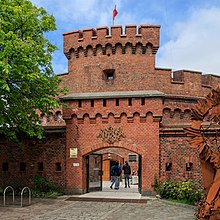Dohna Tower
The Dohnaturm is part of the Königsberg fortification structures , located on the east bank of the Obersee, at the Roßgärter Tor . Built in 1859 and named after Karl Friedrich Emil zu Dohna-Schlobitten , it now houses the Kaliningrad Amber Museum .
history
The Dohnaturm on the east side of the Obersee as a counterpart to the Wrangelturm on the west side was built in 1853. Wrangel and Dohna towers, together with the Oberteich, formed the northern cornerstone of the defense system. In terms of design, it is a Montalembert tower , the first draft of which from the 1840s can be traced back to General Ernst Ludwig von Aster , the Inspector General of the Prussian fortresses at the time . From the towers one could fire at large areas of the apron and the lake and keep the cannons of possible attackers at a respectful distance. Both towers are 34 meters in diameter and 12 meters in height. The artillery of the towers was housed in 42 casemates on two ring-shaped floors. The upper part of the second floor had an open combat area protected by a serrated parapet. The casemate levels and the upper battle area were connected to one another by the spiral staircases arranged in the inner half-towers.
Each of the towers represented an independent fortification and was able to successfully repel enemy attacks through all-round defense. Behind the gate to the Dohnaturm was a forecourt, which was protected on all sides by high walls. From the Oberteich, the main entrance to the tower was protected by a massive L-shaped wall with numerous loopholes. Thick walls also offered the gun casemates safe protection. The latter were connected by a common passage for the purpose of better command transmission and maneuverability of the guns and crews.
At the Battle of Königsberg in early 1945, the towers were used again for military purposes and, when Königsberg was conquered, they represented heavily fortified nests of resistance that had to be removed with considerable effort. After the Königsberg garrison surrendered in April, the soldiers of the Roßgärter Tor fought on for another day and night. The details are no longer known today. Either the command of the fortress commandant Otto Lasch could not be passed on to the soldiers in the gate and in the Dohnaturm behind it, or they refused to obey - in any case they continued to defend the Roßgärter Tor and the Dohnaturm bitterly until their resistance on April 10, 1945 by the 50th Soviet Army under General Oserov was broken. Strangely enough, however, the structure of the gate, including the two high reliefs of Scharnhorst and Gneisenau, was largely spared from artillery fire during the war and from the destruction of the victors after the end of the war.
Like almost all of Königsberg's old fortifications, the Roßgärter Tor was used as a warehouse for bulk goods for years after the war. In 1979 the Amber Museum was set up in the Dohna Tower . With around 14,000 exhibits, it is one of the most important amber museums in the world. The collection includes extraordinary amber finds with rare insect inclusions from the Palmnicken opencast mine , and handicrafts with and made from amber. The visitor will find the largest and oldest treasures in the specially secured cellar vaults, in the "treasure chamber". In 1945, however, the holdings of the former Königsberg amber museum were scattered to the wind. Some of them came to the Königsberg amber collection in Göttingen , other exhibits later appeared in the Lithuanian amber museum Palanga .
From 1927 to 1935 the East Prussia border team, an academic working group for East German issues, was housed in the Dohnaturm. Her motto was: Naer Oostland willen wij rijden .
literature
- Robert Albinus: Königsberg Lexicon. City and surroundings . Flechsig, Würzburg 2002, ISBN 3-88189-441-1 .
- Richard Armstedt : history of the royal. Capital and residence city of Königsberg in Prussia . Reprint of the original edition, Stuttgart 1899.
- Fritz Gause : The history of the city of Königsberg in Prussia. 3 volumes. 2nd / 3rd supplemented edition. Böhlau, Cologne et al. 1996, ISBN 3-412-08896-X .
- Jürgen Manthey : Königsberg - history of a world citizenship republic . Hanser , Munich 2005, ISBN 3-446-20619-1 .
- Gunnar Strunz: Discover Königsberg. Between Memel and fresh lagoon . Trescher, Berlin 2006, ISBN 3-89794-071-X .
- Baldur Köster: Königsberg. Architecture from the German era . Husum Druck, Husum 2000, ISBN 3-88042-923-5 .
Web links
Individual evidence
- ↑ T.Yu. Suvorova: For the 30th anniversary of Kaliningrad Amber Museum: pages of biography. In: Kaliningrad Amber Museum. Pp. 7-20, Kaliningrad 2008.
- ↑ Thomas Thamm: Corporate students in Königsberg / Prussia 1918 to 1945 . Historia Academica (Student History Association of the Coburg Convent) 34, Würzburg 1995, p. 147 f.
Coordinates: 54 ° 43 ' N , 20 ° 31' E

